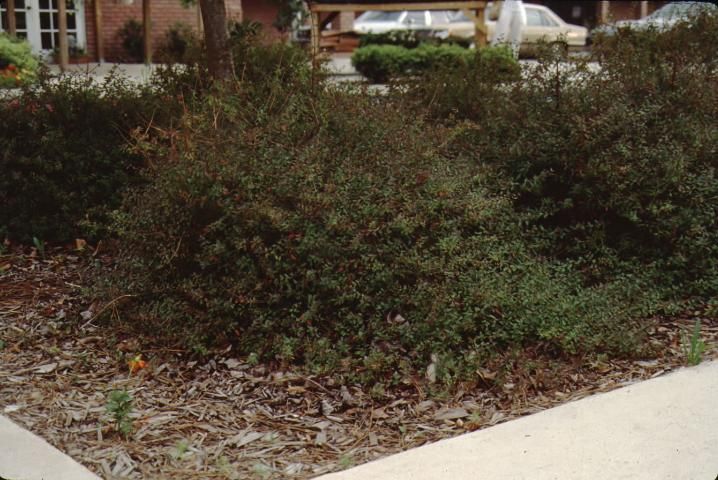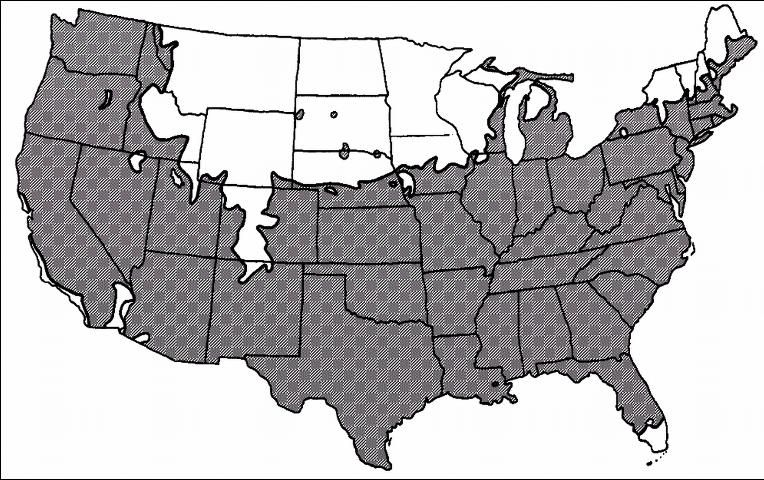Introduction
This popular cultivar of glossy abelia is a fine-textured, semi-evergreen, small shrub with 1½ inch-long, red-tinged leaves arranged along thin, stiff stems. Leaves and flowers are smaller than the species. It is much more compact than the species, resembling the Japanese or yaupon hollies. Considered to be evergreen in its southern range, glossy abelia will lose some of its leaves in colder climates, the remaining leaves taking on a more pronounced red color. Reaching a height of 3 to 6 feet with a spread of 6 to 10 feet, the mounded form of 'Sherwoodii' glossy abelia is clothed from spring through fall with terminal clusters of delicate pink and white, small, tubular flowers.

Credit: Edward F. Gilman, UF/IFAS
General Information
Scientific name: Abelia x grandiflora 'Sherwoodii'
Pronunciation: uh-BEEL-ee-uh gran-dif-FLOR-uh
Common name(s): dwarf glossy abelia, 'Sherwoodii' glossy abelia
Family: Caprifoliaceae
Plant type: shrub
USDA hardiness zones: 5 through 9 (Figure 2)
Planting month for zone 7: year round
Planting month for zone 8: year round
Planting month for zone 9: year round
Origin: not native to North America
Invasive potential: not known to be invasive
Uses: hedge; border; mass planting; attracts butterflies
Availability: somewhat available, may have to go out of the region to find the plant

Description
Height: 3 to 4 feet
Spread: 4 to 6 feet
Plant habit: spreading
Plant density: dense
Texture: fine
Foliage
Leaf arrangement: whorled
Leaf type: simple
Leaf margin: serrate
Leaf shape: ovate
Leaf venation: pinnate
Leaf type and persistence: evergreen
Leaf blade length: less than 2 inches
Leaf color: purple or red
Fall color: purple
Fall characteristic: showy
Flower
Flower color: pink
Flower characteristic: spring flowering; summer flowering; fall flowering; pleasant fragrance
Fruit
Fruit shape: oval
Fruit length: less than 1/2 inch
Fruit cover: dry or hard
Fruit color: tan
Fruit characteristic: inconspicuous and not showy
Trunk and Branches
Trunk/bark/branches: not particularly showy; typically multi-trunked or clumping stems
Current year stem/twig color: reddish
Current year stem/twig thickness: thin
Culture
Light requirement: plant grows in part shade/part sun
Soil tolerances: slightly alkaline; clay; sand; acidic; loam
Drought tolerance: moderate
Soil salt tolerance: poor
Plant spacing: 36 to 60 inches
Other
Roots: usually not a problem
Winter interest: plant has winter interest due to unusual form, nice, persistent fruits, showy winter trunk, or winter flowers
Outstanding plant: not particularly outstanding
Pest resistance: no serious pests are normally seen on the plant
Use and Management
Ideally suited as a low-growing foundation plant, abelia is also excellent as a tall ground cover for a large-scale commercial or industrial landscape. It can be sheared into a formal hedge or into any of a number of topiary shapes. It's nicely suited for training into a low hedge bordering a sidewalk. Growth rate is slow to moderate, making it easy to keep it from growing out of bounds with two clippings per year.
Space plants 4 to 5 feet apart in a mass planting. Be sure to set plants several feet back from a walk, driveway or lawn area, because plants grow wider than tall and often require pruning to control their lateral growth. If you need to prune in this manner, be sure to leave the bottom of the plant much wider than the top so lower foliage is left on the plant. If you attempt to shear vertically, the lower branches are shaded and often lose foliage. This will give the shrub an unsightly, dark, leafless bottom.
Glossy abelia enjoys fairly rich, moist but well-drained soil in a full sun or lightly shaded location and has good drought tolerance. Plants become thin and unattractive in the shade and do not flower. Plant on 4- to 6-foot centers to form a foundation planting, slightly closer for a hedge. The foliage darkens during the winter, but plants generally remain full all during the cold months.
Cultivars include: 'Francis Mason' - new green foliage changes to glossy yellow as it matures, color more noticeable in full sun, light pink flowers, 3 to 4 feet high; and 'Prostrata' - prostrate growth habit, white flowers, sometimes used as a ground cover. Abelia 'Edward Goucher', a hybrid between Abelia x grandiflora and Abelia schumannii, has abundant lavender-pink flowers and showy red calyces, reaches 5 feet, and is best used in USDA hardiness zone 6.
Propagation is by cuttings of long, leafless, hardwood stems taken in November to January.
Design Considerations
Glossy abelia works well as a background or massing plant to highlight the forms and colors of companion plants. The fine texture and small leaves of the abelia will show well with contrasting plant features such as large leaves, coarse texture, thick stems, and dark green color. Contrasting size and shape such as low-growing groundcover with a sprawling, mounding form will emphasize the upright, vase shape of abelia. To create plant masses in large areas select plants with similar characteristics that blend with abelia. Similar textures include thin blades and clumping, arching forms of grasses and other vase-shaped, small leaved shrubs. The compact form of 'Sherwoodii' pairs well with taller shrubs with large coarse leaves.
Pests and Diseases
None of major concern but occasionally the plant is bothered by aphids.